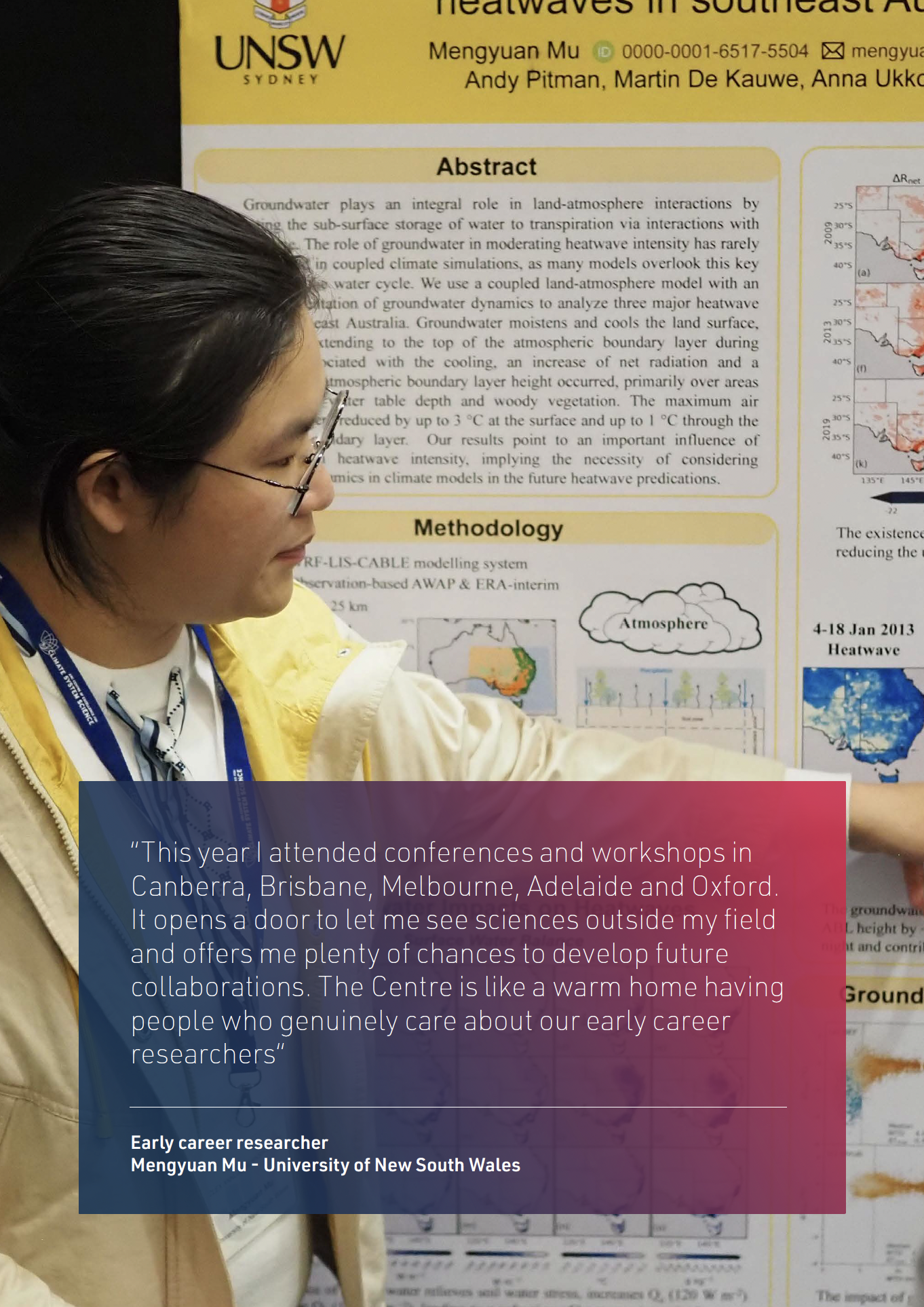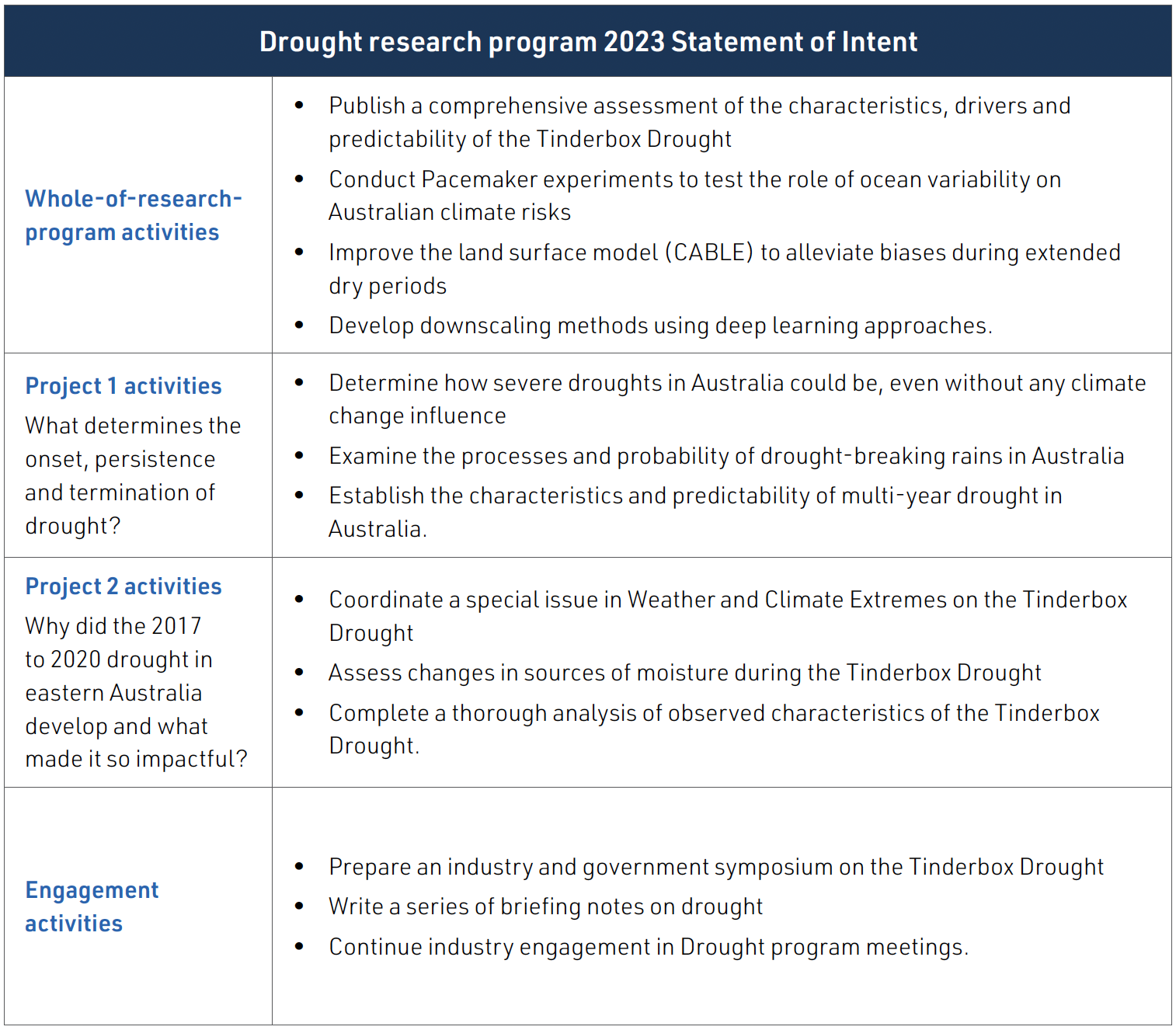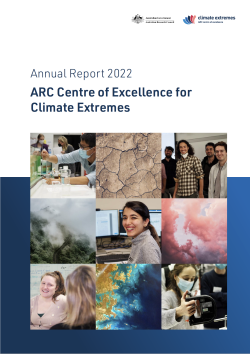The ARC Centre of Excellence for Climate Extremes’ Drought research program has had a very productive year, including building momentum through two in-person workshops of the research team.
In March 2022 the program’s Chief Investigators and postdoctoral researchers met and developed a plan to draw together the diverse expertise of the team around a case study to understand the intense drought that impacted south-east Australia between 2017 and early 2020 – a drought which we have termed the Tinderbox Drought.
In August the research program team met in-person again to discuss progress on this case study, resulting in the development of a comprehensive review paper on the characteristics, drivers and predictability of this intense drought.
Dr Anjana Devanand gave an invited talk on this Tinderbox Drought review at the Centre’s annual workshop in November, and work is now under way to finalise the paper for publication. The Drought program team is also coordinating a special issue on the Tinderbox Drought in Weather and Climate Extremes. It has already received its first submissions and will be open to more until late 2023.
PROJECT 1
What determines the onset, persistence and termination of drought?
Large-scale climate modes, such as El Niño and positive Indian Ocean Dipole events, are often linked to increased drought risk in parts of eastern Australia. However, the weather processes connecting these broad-scale, distant features to local rainfall are unclear.
Dr Chiara Holgate and co-authors have shown, in research published in Journal of Climate, that East Australia is wetter during La Niña because more moisture is transported into the region and is more easily turned into rainfall when it arrives, whereas drier conditions during El Niño are because local conditions inhibit the conversion of moisture into rainfall. Distant atmospheric changes over the Indian and Southern Oceans can intensify these changes. These results can be used to better understand and predict the regional impact of long-term changes in these modes of climate variability, which are potentially altered under climate change.
Dr Holgate was also recognised as a Superstar of STEM in 2022. She will spend the next two years developing her communications skills to help Australians better understand and prepare for future extreme events – and to show rural kids what it’s like to be an engineer and scientist.
Our drought research is also being applied to help the agricultural industry better understand and predict climate extremes. Our Chief Investigators contributed to research exploring time-series yield and crop production from cotton sites in Australia and related them to climatic variations. This study found that dryland lint yield gains during average-to-moderate rain/temperature years, while irrigated lint yields have improved during more-frequent average rain/hot growing seasons. The work also discovered that climate in central cotton-growing areas is affected by Central Pacific and Western Pacific Nino indices. These findings translate into meaningful actions for industry adaptation and in turn provide a valuable step in accounting for climate variability and yield-related inputs such as fertiliser and water resources.
Additionally, our research contributed to work looking at the impact of large-scale climate modes on wheat production in Australia. The research, published in Nature Food, found that the influence of the tropical Pacific has decreased since the 1990s, while the impact of the Indian Ocean Dipole on Australian wheat yields has strengthened. These findings are critical for ensuring that seasonal forecasting adapts to the changing effects of climate variability on Australian agricultural yields.
PROJECT 2
Why did the 2017 to 2020 drought in eastern Australia develop and what made it so impactful?
This case study has focused the combined efforts of the Drought research program with a diversity of research being done to define the characteristics, the small and large-scale drivers and the predictability of the Tinderbox Drought. For example, did interactions between the land and the atmosphere intensify the hot and dry extremes towards the end of the Tinderbox Drought and also during Australia’s Black Summer fire disaster that punctuated the end of this severe drought?
Research led by Dr Mengyan Mu, published in Weather and Climate Extremes ,has found that groundwater plays an integral role in land-atmosphere interactions by connecting the sub-surface storage of water to transpiration via interactions with the root zone. The role of groundwater in moderating heatwave intensity has rarely been examined in coupled climate simulations, as many models overlook this key component of the water cycle. Dr Mu used a coupled land-atmosphere model with an explicit representation of groundwater dynamics to analyse three major heatwave events in south-east Australia.
Groundwater moistens and cools the land surface, with impacts extending to the top of the atmospheric boundary layer during heatwaves. Associated with this cooling, there occurred an increase of net radiation and a reduction in the atmospheric boundary-layer height, primarily over areas with a shallow water-table depth and woody vegetation. The maximum air temperatures were reduced by up to 3 °C at the surface and up to 1 °C through the atmospheric boundary layer. The results point to an important influence of groundwater on heatwave intensity, implying the necessity of considering groundwater dynamics in climate models for future heatwave predictions.
Jon Cranko Page also led Centre research examining the time scales of carbon and water fluxes across Australian ecosystems. Although vegetation responds to climate at a wide range of time scales, models of the land-carbon sink often ignore responses that do not occur instantly. In this study, our researchers identified that carbon and water fluxes can be modelled more accurately if we include environmental drivers from up to a year in the past. The importance of antecedent conditions is related to ecosystem aridity but is also influenced by other factors.
Undergraduate summer scholar, Dejun Cai, published his research project in Environmental Research Letters. This work looked at cold fronts and identified a significant connection between cold fronts passing over south-east Australia and days of large fires burning across Australia’s Black Summer. This type of connection has been demonstrated for individual fire days before, but this is the first time it has been demonstrated across an entire fire season. The work showed that the extreme cold-front conditions during the Black Summer were part of a long-term increase in the number and intensity of strong cold fronts passing over south-east Australia and that, if these trends continue, then fire-promoting weather conditions such as these will imminently move outside of the range of historical experience.

RESEARCH SNAPSHOT

The Southern Annular Mode is a major mode of climate variability that influences climate extremes across the Southern Hemisphere, including drought in southern Australia. Proxy-based Southern Annular Mode reconstructions show large changes during the last millennium that current climate simulations don’t reproduce. Research led by Dr Nicky Wright tested the Southern Annular Mode’s sensitivity to solar forcing by using simulations with a range of constant solar values and transient last-millennium simulations with large-amplitude solar variations. The work found that solar forcing can alter the Southern Annular Mode and that transient simulations forced with a large-amplitude option for solar forcing during the last millennium better match proxy-based reconstructions. The findings suggest that the effects of solar forcing on high-latitude climate may not be adequately incorporated in most last-millennium simulations, due to solar irradiance changes that are too small and/or the absence of interactive atmospheric chemistry in global climate models.
Wright, N.M., Krause, C.E., Phipps, S.J., Boschat, G., Abram, N.J., 2022. Influence of long-term changes in solar irradiance forcing on the Southern Annular Mode. Climate of the Past 18, 1509–1528. https://doi.org/10.5194/cp-18-1509-2022
RESEARCH SNAPSHOT
Australia’s rainfall is highly variable, and long-term (100-plus years) observational records from rain gauges are limited, making it difficult to develop robust water policies and infrastructure that mitigates and adapts to future rainfall extremes. Relying solely on the severity of droughts and floods experienced since observations and meteorological record-keeping began in Australia for water-resource management decisions leaves communities, agriculture and industry vulnerable to infrastructure failure when the magnitude of future droughts or floods exceed previously experienced extremes.
In her 2022 paper, Danielle Udy led research that uses a method called ‘synoptic typing’ to group combinations of synoptic-scale weather systems (for example, high and low pressure systems) together to show that ice cores in East Antarctica and rainfall in Australia are connected by an ‘atmospheric bridge’. Summer seasons with increased sea-salt concentrations in the ice core and above-average rainfall conditions over subtropical eastern Australia are connected through the ‘atmospheric bridge’ that causes the following: increased wind speeds and sea-salt spray generation over the Southern Ocean near Law Dome; favourable conditions for widespread rainfall over mainland eastern Australia; and dry conditions over western Tasmania (for example, 2010/11 and 2021/22 summers with widespread flooding). In contrast, low sea-salt concentrations in the ice core are associated with synoptic-scale weather systems that cause hot and dry conditions over mainland eastern Australia and cool and wet conditions over Tasmania (for example, 2019/20 summer with severe bushfires). This study improves the understanding of the weather-scale processes linking the Law Dome ice core record to East Australian rainfall, which is vital for advancing how drought and flooding challenges are managed both currently and in the future.
Udy, D.G., Vance, T.R., Kiem, A.S., Holbrook, N.J., 2022. A synoptic bridge linking sea salt aerosol concentrations in East Antarctic snowfall to Australian rainfall. Commun Earth Environ 3, 175. https://doi.org/10.1038/s43247-022-00502-w

ARC Centre of Excellence for Climate Extremes – Annual Report 2023
From the Chair of the Advisory Board
Climate Science Leaders of the Future
Weather and Climate Interactions Research Program
Attribution and Risk Research Program
Ocean Extremes Research Program
Computational Modelling Systems
Governance, Management and our Commitment to Equity, Diversity and Inclusion

